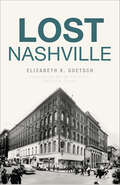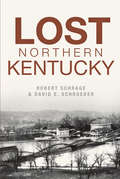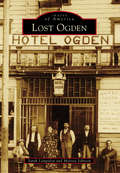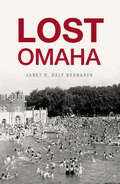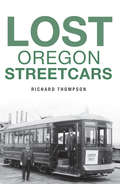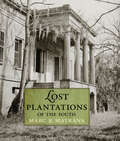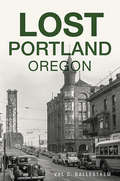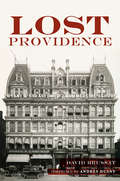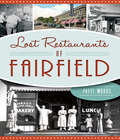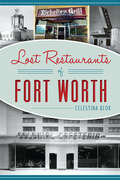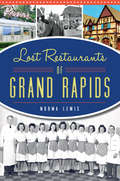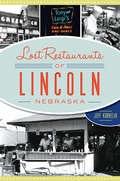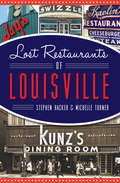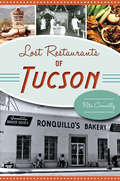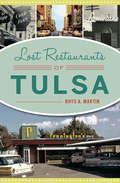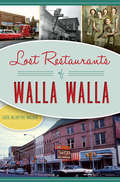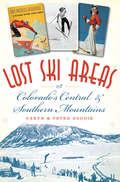- Table View
- List View
Lost Nashville (Lost)
by Elizabeth K. GoetschNashville is chock-full of music landmarks, but there are quite a few historic structures that have been lost to time. The elegant Maxwell House Hotel served a breakfast blend that grew into the nationally known coffee brand. Public transportation first arrived in Nashville by way of horse-pulled streetcars in the 1860s. Fort Negley was the largest stone fort built during the Civil War. The Nashville Female Academy once served as the largest school for young ladies in the United States during the nineteenth century. Author Elizabeth Goetsch digs into the archives for some of the Music City's lost structures.
Lost Northern Kentucky (Lost)
by Robert Schrage David E. SchroederNorthern Kentucky has a unique location as the gateway between the North and the South. Many of its historic businesses, religious structures, homes and buildings were lost to time. Just after the Civil War, Daniel Henry Holmes purchased a large Victorian-Gothic house he named Holmesdale, better known as Holmes Castle. By the 1890s, the Latonia Racetrack had two hundred stables to accommodate horses and space for one hundred bookmakers. The Motordrome at the Ludlow Lagoon Amusement Park had seating for eight thousand people. Authors Robert Schrage and David Schroeder detail the fascinating history of Northern Kentucky's lost treasures.
Lost Ogden
by Sarah Langsdon Melissa JohnsonFrom a fur-trapping fort to a thriving metropolitan community, change has always been a part of Ogden's history. Settled in 1850 by Mormon pioneers, Ogden was forever transformed by the arrival of the transcontinental railroad in 1869. As horse-drawn carriages gave way to motor cars, a busy downtown district grew up around Ogden's Union Station and notorious Twenty-fifth Street. Landmark businesses, such as J.G. Read & Brothers Company and the Broom Hotel, became a part of the city's unique identity. Also unique to the city were its celebrations and special events, like parades, musicals, and sporting competitions. While change has always come to Ogden, the memories remain.
Lost Omaha (Lost)
by Janet R. BednarekThe landmarks of Omaha's past reveal a history of industry, innovation and change. The Hotel Fontenelle, the Omaha Athletic Club and the Medical Arts Building disappeared in the wake of changes remaking downtown after World War II. Jobbers Canyon, a vital part of the city's wholesale district, was sacrificed to ConAgra's headquarters. Peony Park closed as suburban sprawl prevented its expansion, and changing leisure patterns took residents farther away for their amusement park experience. The stockyards finally closed in 1999, ending a long chapter in Omaha's history. Author and historian Janet R. Daly Bednarek charts the legacy of Omaha's lost history through its landmarks.
Lost Ordinary Magic: Simple things in a complicated world
by Rob LoweLost Ordinary Magic is a book about simple things (such as: being alone, nonsense, pockets and spontaneity) told through personal stories, and observations, that are universal. The forced complexity of modern life means we are so busy dealing with a constant babble of advertising, news and social media, that it can be easy to forget that life can be simple and, often, the things that connect us and bring us joy are simple too.This book is a chance to take a break from our chaotic world and reconnect with the Lost Ordinary Magic all around us.
Lost Ordinary Magic: Simple things in a complicated world
by Rob LoweLost Ordinary Magic is a book about simple things (such as: being alone, nonsense, pockets and spontaneity) told through personal stories, and observations, that are universal. The forced complexity of modern life means we are so busy dealing with a constant babble of advertising, news and social media, that it can be easy to forget that life can be simple and, often, the things that connect us and bring us joy are simple too.This book is a chance to take a break from our chaotic world and reconnect with the Lost Ordinary Magic all around us.
Lost Oregon Streetcars
by Richard ThompsonThe streetcars that plied Oregon’s small-town streets were every bit as diverse as those in Portland and their history even more fascinating. Learn of the devastating 1922 fire that scorched Astoria’s plank road railways and put a halt to its once-thriving streetcar network. Muse over the tale of a beloved white horse named Old Charlie that proved more efficient at powering Albany’s streetcars than the alternative steam locomotive. Laugh at the spectacle of university students being carted back to their dormitories on the Eleventh Street Line’s special midnight “drunk express” trains. Take pride in the tiny town of Cherry Grove, which became the first in the West to embrace new battery technology. Local historian Richard Thompson celebrates the lost trolley lines that transported Oregon’s people across the state for decades.
Lost Plantation: The Rise and Fall of Seven Oaks
by Marc R. MatranaAlong the fertile banks of the Mississippi River across from New Orleans, planter Camille Zeringue transformed a mediocre colonial plantation into a thriving gem of antebellum sugar production, complete with a columned mansion known as Seven Oaks. Under the moss-strewn oaks, the privileged master nurtured his own family, but enslaved many others. Excelling at agriculture, business, an ambitious canal enterprise, and local politics, Zeringue ascended to the very pinnacle of southern society. But his empire soon came crashing down. After the ravages of the Civil War and a nasty battle with a railroad company, the family eventually lost the great estate. Seven Oaks ultimately ended up in the hands of distant railroad executives whose only desire was to rid themselves of this heap of history. Lost Plantation: The Rise and Fall of Seven Oaks tells both of Zeringue's climb to the top and of his legacy's eventual ruin. Preservationists and community members abhorred the railroad's indifferent attitude, and the question of the plantation mansion's fate fueled years of fiery, political battles. These hard-fought confrontations ended in 1977 when the exasperated railroad executives sent bulldozers through the decaying house. By analyzing one failed effort, Lost Plantation provides insight into the complex workings of American historical preservation efforts as a whole, while illustrating how southerners deal with their multifaceted past. The rise and fall of Seven Oaks is much more than just a local tragedy—it is a glaring example of how any community can be robbed of its history. Now, as parishes around New Orleans recognize the great aesthetic and monetary value of restoring plantation homes and attracting tourism, Jefferson Parish mourns a manor lost.
Lost Plantations of the South
by Marc R. MatranaThe great majority of the South's plantation homes have been destroyed over time, and many have long been forgotten. In Lost Plantations of the South, Marc R. Matrana weaves together photographs, diaries and letters, architectural renderings, and other rare documents to tell the story of sixty of these vanquished estates and the people who once called them home. From plantations that were destroyed by natural disaster such as Alabama's Forks of Cypress, to those that were intentionally demolished such as Seven Oaks in Louisiana and Mount Brilliant in Kentucky, Matrana resurrects these lost mansions. Including plantations throughout the South as well as border states, Matrana carefully tracks the histories of each from the earliest days of construction to the often-contentious struggles to preserve these irreplaceable historic treasures. Lost Plantations of the South explores the root causes of demise and provides understanding and insight on how lessons learned in these sad losses can help prevent future preservation crises. Capturing the voices of masters and mistresses alongside those of slaves, and featuring more than one hundred elegant archival illustrations, this book explores the powerful and complex histories of these cardinal homes across the South.
Lost Portland, Oregon (Lost)
by Val C. BallestremAs Portland has grown and changed, so has its architectural landscape. Once prominent landmarks have disappeared--the Marquam Building collapsed during 1912 renovations, the massive chamber of commerce building became a parking lot and the Corbett Building became a shopping mall. The city skyline was shaped by architects like Justus F. Krumbein and David L. Williams, only to drastically change in the face of urban renewal and the desire for modernization. Discover the stories behind some of Portland's most iconic buildings, including the Beth Israel Synagogue and the first East Side High School, both lost to fire. Join historian Val C. Ballestrem as he explores the city's architectural heritage from the 1890s to the present, as well as the creative forces behind it.
Lost Providence (Lost)
by Andres Duany David BrussatProvidence has one of the nation�s most intact historic downtowns and is one of America�s most beautiful cities. The history of architectural change in the city is one of lost buildings, urban renewal plans and challenges to preservation. The Narragansett Hotel, a lost city icon, hosted many famous guests and was demolished in 1960. The American classical renaissance expressed itself in the Providence National Bank, tragically demolished in 2005. Urban renewal plans such as the Downtown Providence plan and the College Hill plan threatened the city in the mid-twentieth century. Providence eventually embraced its heritage through plans like the River Relocation Project that revitalized the city�s waterfront and the Downcity Plan that revitalized its downtown. Author David Brussat chronicles the trials and triumphs of Providence�s urban development.
Lost Restaurants of Fairfield (American Palate)
by Patti WoodsThe culinary history of Fairfield, Connecticut, brims with bygone and beloved eateries and watering holes. Discover some of these lost classics, from the Sun Tavern--where George Washington enjoyed a few victuals--to the Scenario, where local celebrities always had a seat reserved at the bar. The best doughnuts in town were at the corner of Post and Beaumont at Devore's, while Art Green served up his famous chocolate cream pies at the Pie Plate. Join author Patti Woods for a generous serving of nostalgia complete with nachos from Sidetrack's, chili from Kuhn's and maybe even an ice cold beer from the Driftwood.
Lost Restaurants of Forth Worth (American Palate)
by Celestina BlokDespite a thriving culinary scene, Fort Worth lost some of its most iconic restaurants decades ago. Locals still buzz about the legendary chili dished out at historic Richelieu Grill and the potato soup Sammy's served all night. Fort Worth could accommodate every palate, from the Bakon Burger at Carlson's Drive-Inn to the escargot and chateaubriand laid out at the Carriage House. Even movie stars like Bob Hope and Gene Autry frequented the city for steaks from the Seibold Café, and President Lyndon B. Johnson loved Cowtown for the barbecue from famed chuckwagon cook Walter Jetton. Join food writer Celestina Blok as she journeys through her hometown's dining past.
Lost Restaurants of Grand Rapids (American Palate)
by Norma LewisGrand Rapids restaurants have served up meals and memories since the city's earliest days. At Bentham's, one of the first downtown restaurants, customers without money to eat could trade an animal pelt for supper. John Sebaitis trained his German shepherd, Spooky, to serve beer to the patrons at his tavern. And a seventeen-year-old Gerald R. Ford worked part time as a server and dish washer at Bill's Place. Join Norma Lewis as she explores the history of Grand Rapids' most beloved eateries and the stories behind them.
Lost Restaurants of Louisville (American Palate Ser.)
by Michelle Turner Stephen HackerLouisville was home to fine cuisine long before the famous restaurant rows on Bardstown Road, Frankfort Avenue and East Market Street. Mazzoni's served the area's first rolled oyster. At the C-54 Grill, guests dined inside a remodeled aircraft, and Kaelin's prepared its classic cheeseburger. Hasenour's sauerbraten and Hoe Kow's war sui gai are two dishes that still make local mouths water when mentioned. Authors Stephen Hacker and Michelle Turner revisit the vivid personalities, celebrated spaces and unique recipes that made Louisville's historic eateries unforgettable.
Lost Restaurants of Tucson (American Palate)
by Rita ConnellyFrom western roadhouses to fine dining, Tucson boasts an extraordinary lineup of diverse restaurants. Though some of its greatest no longer exist, their stories conjure the sights, smells and sounds of the city's history. Longtime locals still buzz about Gordo's famous chimichangas, an accidental dish originating in Tucson. The legendary Tack Room was a beacon of fine dining. Places like Café Terra Cotta and Fuego pioneered a new southwestern cuisine, serving regional dishes like prickly pear pork and stuffed poblanos. University of Arizona alumni miss old spots like the Varsity, while long-gone haunts like Gus & Andy's attracted a unique crowd of businessmen, movie stars and the occasional mobster. Join local food writer Rita Connelly as she serves up savory stories of good food and good company from the gone but never forgotten favorites of the Old Pueblo.
Lost Restaurants of Tulsa (American Palate)
by Rhys A. MartinIn the early twentieth century, Tulsa was the "Oil Capital of the World." The rush of roughnecks and oil barons built a culinary foundation that not only provided traditional food and diner fare but also inspired upper-class experiences and international cuisine. Tulsans could reserve a candlelit dinner at the Louisiane or cruise along the Restless Ribbon with a pit stop at Pennington s. Generations of regulars depended on family-owned establishments such as Villa Venice, The Golden Drumstick and St. Michael's Alley. Join author Rhys Martin on a gastronomic journey through time, from the Great Depression to the days of "Liquor by the Wink" and the Oil Bust of the 1980s.
Lost Restaurants of Tulsa (American Palate)
by Rhys A. MartinIn the early twentieth century, Tulsa was the "Oil Capital of the World." The rush of roughnecks and oil barons built a culinary foundation that not only provided traditional food and diner fare but also inspired upper-class experiences and international cuisine. Tulsans could reserve a candlelit dinner at the Louisiane or cruise along the Restless Ribbon with a pit stop at Pennington's. Generations of regulars depended on family-owned establishments such as Villa Venice, The Golden Drumstick and St. Michael's Alley. Join author Rhys Martin on a gastronomic journey through time, from the Great Depression to the days of "Liquor by the Wink" and the Oil Bust of the 1980s.
Lost Restaurants of Walla Walla (American Palate)
by Catie McIntyre WalkerDining in Walla Walla blossomed from an influx of mining transplants in the late 1800s. Within decades, a roadhouse called the Oasis boasted a seventy-two-ounce slab of beef, and the old Pastime Café opened at 5:30 a.m. with white toast and whiskey for breakfast. In the early 1950s, Ysidro Berrones opened one of the valley's first Mexican restaurants, the El Sombrero Tortilla Factory and Café. Owner of Denney's Hi-Spot for two decades, Joe Denney also satisfied locals with his morning crooning to piano on KTEL. Native and local wine writer Catie McIntyre Walker celebrates this rich heritage with decades of departed, beloved establishments and the people behind them.
Lost Rights: The Misadventures of a Stolen American Relic
by David HowardNear the close of the Civil War, as General Sherman blazed his path to the sea, an unknown infantryman rifled through the North Carolina state house.The soldier was hunting for simple Confederate mementos—maps, flags, official correspondence—but he wound up discovering something far more valuable. He headed home to Ohio with one of the touchstones of our republic: one of the fourteen original copies of the Bill of Rights. Lost Rights follows that document’s singular passage over the course of 138 years, beginning with the Indiana businessman who purchased the looted parchment for five dollars, then wending its way through the exclusive and shadowy world of high-end antiquities—a world populated by obsessive archivists, oddball collectors, forgers, and thieves— and ending dramatically with the FBI sting that brought the parchment back into the hands of the government. For fans of The Billionaire’s Vinegar and The Lost Painting, Lost Rights is “a tour de force of antiquarian sleuthing” (Hampton Sides).
Lost Rochester, Minnesota (Lost)
by Amy Jo HahnRochester is synonymous with one of its most famous landmarks, the Mayo Clinic, but there's so much more to the Med City. It began as a frontier town, struggling to make its mark in a sparsely populated wilderness. By the late nineteenth century, Rochester had expanded into a vibrant city, rich with business, educational and cultural opportunities. Rediscover the Dubuque Trail and the beautiful summer lake retreats, along with the Cook Hotel, the Central Fire Station and more. Author Amy Jo Hahn uncovers the lost beginnings of Rochester and brings the stories of this unique place to life.
Lost Sandusky (Lost)
by M. Kristina SmithSANDUSKY BUILT ITS REPUTATION on the appeal of a picturesque lakefront and the opportunities of a manufacturing hub. Not only did its factories keep pace with the transportation industry, but the Ohio city also boasted the headquarters of international paper maker Hinde and Dauch and enough crayon production to be called the "Color Capital of the World." The amusement park at Cedar Point helped launch a new form of entertainment that continues today. But while the town remains a vacation destination and retains some heavy industry, it misses much of its former glory. Join M. Kristina Smith in revisiting those landmarks of Sandusky's past.
Lost Ski Areas of Colorado's Central and Southern Mountains
by Peter Boddie Caryn BoddieColorado's central and southern mountains still draw droves of skiers to the slopes. However, many of the historic runs and areas that were popular over the past century--some near the current resorts of Aspen, Breckenridge, Crested Butte, Purgatory, Telluride and Vail--no longer exist. Local hills like Whittaker Ranch near Eagle featured little more than a rope tow and warming hut. Now underneath Lake Dillon, Prestrud Jump hosted tournaments where Olympian Anders Haugen broke ski-jumping world records. From Lands End near Grand Junction to Sugarite near Trinidad, from swanky Hoosier Pass in Summit County to Stoner in Montezuma County, authors Caryn and Peter Boddie take readers on a tour of the lost ski areas of central and southern Colorado.
Lost Ski Areas of the Berkshires (Lost)
by Jeremy K. DavisThe Berkshires of Massachusetts have long been known as a winter sports paradise. Forty-four ski areas arose from the 1930s to the 1970s. The Thunderbolt Ski Trail put the Berkshires on the map for challenging terrain. Major ski resorts like Brodie Mountain sparked the popularity of night skiing with lighted trails. All-inclusive resorts--like Oak n' Spruce, Eastover and Jug End--brought thousands of new skiers into the sport between the 1940s and 1970s. Over the years, many of these ski areas faded away and are nearly forgotten. Jeremy Davis of the New England/Northeast Lost Ski Areas Project brings these lost locations back to life, chronicling their rich histories and contributions to the ski industry.
